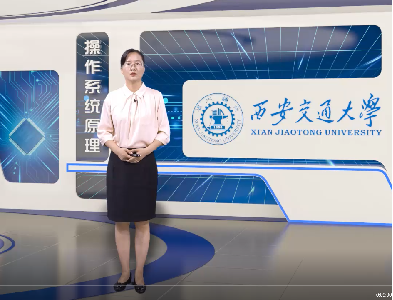
当前课程知识点:Fundamentals of Inorganic Materials Science > 4 Melt and glass > 4.3 The characteristics of glass > 4.3 The characteristics of glass
返回《Fundamentals of Inorganic Materials Science》慕课在线视频课程列表
返回《Fundamentals of Inorganic Materials Science》慕课在线视频列表
同学们好,
之前我们学习了熔体的结构与性质。
从今天开始我们来学习玻璃的相关知识。
首先,我们来认识一下玻璃具有什么样的通性。
玻璃的通性有四点,
我们逐一来学习。
第一条通性,玻璃具有各向异性。
这是指玻璃各方向的性质
如折射率、硬度、弹性模量、
热膨胀系数、导热系数等都相同,
当然这只针对于均质玻璃。
之所以具有这样的性质,
是由于玻璃内部质点无规则排列,
因此统计的来看,各个方向质点的排列都是相同的,
性质也是相同的。
第二条通性,玻璃具有介稳性。
所谓介稳性,
是指从热力学上看,玻璃能量较高,
有析晶的趋势,
但从动力学的角度看,
玻璃发生析晶的速率很慢,
因此可以以高能量的玻璃态形式长期介稳存在。
那么怎么理解玻璃的高能量状态呢?
我们可以从冷却过程中熔体的状态转变来分析。
随着温度降低,熔体的能量逐渐下降。
当冷却到熔点温度时,
开始从熔体中析出晶体,
释放出相变潜热,
熔体在熔点温度下逐渐转变为晶体,
体系能量在熔点温度下急剧下降。
当熔体完全转变为晶体后,
随着温度降低,晶体的能量连续下降。
但是,在熔点下发生析晶时,
质点需要重新排列,需要一定时间。
如果冷却速率很快,
快到质点来不及调整位置,
那么,
体系可以在熔点温度下继续保持熔体的状态,
此时的熔体叫过冷液体,
能量随温度仍然连续下降。
当温度降低到Tg温度时,
熔体黏度很高,
完全失去流动性,
体系由液态转变为固态,
形成玻璃,
这个温度我们称为玻璃形成温度。
但是体系的结构调整不明显,
也没有释放相变潜热。
因此能量随温度仍然连续变化。
由此可见,
玻璃的能量高于晶体。
同时,
大家也要认识到,
玻璃转变温度与冷却速率有关,
冷却速率越快,玻璃转变温度越高,
形成玻璃后体系的能量越高,
玻璃的结构越开放。
因此,
由熔体转变为玻璃是在一个温度段内发生的,
与析晶不同,玻璃没有熔点。
第三条通性,凝固时的渐变性和连续性。
大家可以由刚才的分析清晰的看到这一点,
由熔融态向玻璃态转变时
体系的结构、能量、体积等都是连续变化的,
没有突跳。
这与析晶完全不同。
这是在玻璃生产中,
废玻璃可以回收重复利用的原因。
第四条通性,由熔融态向玻璃态转变时,
物理化学性质随温度变化的连续性。
不同的性质如电导、比热、密度、膨胀系数、
热导、弹性系数等
随温度的变化曲线不尽相同。
从数学的角度看,
有的存在极值,
有的存在拐点,
有的既无极值也无拐点。
但是,性质发生明显变化的温度区间相同。
我们把这个区间的下限温度称为玻璃形成温度,
表示为Tg。
上限温度称为玻璃软化温度,
表示为Tf。
玻璃形成温度又称脆性温度。
它是玻璃出现脆性的最高温度,
这个温度以下
材料黏度很高,
具有脆性。
同时,在这个温度下
可以消除玻璃制品因不均匀冷却而产生的内应力,
所以也称退火温度上限。
而软化温度是玻璃
开始出现液体状态典型性质的温度,
黏度较低,
即具有明显的流动性。
因此,
这个温度也是玻璃可拉成丝的最低温度。
讲到这里,大家可能要问,
Tg温度以下材料呈固态,具有脆性,
Tf温度以上材料呈液态,具有明显流动性。
那么温度处于两者之间的材料
是固液混合态?
答案是否定的,
在该温度区间内,
材料依然是均匀的一种物相,
材料的黏度处于中间状态,
具有粘弹性。
好,以上就是玻璃具有的四条通性,
可以认为具有这四条性质的材料就是玻璃。
这一讲就到这里,谢谢!
-Test for chapter 1
-2.1 Type of defect
-2.2.1 The expression methods of point defects
--2.2.1 The expression methods of point defects
--2.2.1 The expression methods of point defects
-2.2.2 The rules for writing of defect reaction equation
--2.2.2 The rules for writing of defect reaction equation
--2.2.2 The rules for writing of defect reaction equation
-2.3 Calculation of thermal defect concentration
--2.3 Calculation of thermal defect concentration
--2.3 Calculation of thermal defect concentration
-2.4 Non-stoichiometric compounds
--2.4 Non-stoichiometric compounds
--2.4 Non-stoichiometric compounds
-Homework for chapter 2
-Test for chapter 2
-3.1 The classification of solid solutions
--3.1 The classification of solid solutions
--3.1 The classification of solid solutions
-3.2 Substitutional solid solution
--3.2 Substitutional solid solution
--3.2 Substitutional solid solution
-3.3 Interstitial solid solution
--3.3 Interstitial solid solution
--3.3 Interstitial solid solution
-3.4 The research method of solid solutions
--3.4 The research method of solid solutions
--3.4 The research method of solid solutions
-3.5 Questions for crystal imperfection and solid solution
--Questions for crystal imperfection and solid solution
-Homework for chapter 3
-Test for chapter 3
-4.1 Melt structure
-4.2 The properties of the melt
--4.2.1 The properties of the melt_viscosity
--4.2.2 The properties of the melt_surface tension
--4.2 The properties of the melt
-4.3 The characteristics of glass
--4.3 The characteristics of glass
--4.3 The characteristics of glass
-4.4 The formation of glass
--4.4.1 The formation of glass_kinetics conditions
--4.4.2 The formation of glass_crystal chemical conditions
-4.5 The structure of glass
-4.6 The typical glass
-4.7 Questions for melt and glass
--Questions for melt and glass
-Test for chapter 4
-5.1 Phase equilibrium in silicate systems
--5.1 Phase equilibrium in silicate system
--5.1 Phase equilibrium in silicate system
-5.2 One-component system phase diagram
--5.2 One-component system phase diagram
--5.2 One-component system phase diagram
-5.3 Applications of one-component diagrams
--5.3 Applications of one-component diagrams
--5.3 Applications of one-component diagrams
-5.4 Binary diagrams
--5.4.1 Binary diagram with eutectic point
--5.4.2 Binary system with a congruent melting compound and one with an incongruent melting compound
--5.4.3 Other five types of phase diagrams of binary systems
-5.5 Applications of binary phase diagrams
--5.5 Applications of binary phase diagrams
--5.5 Applications of binary phase diagrams
-5.6 Ternary diagrams
--5.6.1 Representation of ternary system composition
--5.6.1 Representation of ternary system composition
--5.6.2 Three-dimensional state diagram and plane projection diagram of a simple ternary system
--5.6.2 Three-dimensional state diagram and plane projection diagram of a simple ternary system
--5.6.3 (1) Basic types of ternary phase diagrams
--5.6.3 (2) Basic types of ternary phase diagrams
--5.6.3 (3) Basic types of ternary phase diagrams
--5.6.3 Basic types of ternary phase diagrams
-5.7 Applications of ternary phase diagrams
--5.7 Applications of ternary phase diagrams
--5.7 Applications of ternary phase diagrams
-5.8 Research methods of phase equilibrium
--5.8 Research methods of phase equilibrium
--5.8 Research methods of phase equilibrium
-5.9 Questions for phase equilibria
--Questions for phase equilibria
-Homework for chaper 5
-Test for chapter 5
-6.1 Overview of diffusion
-6.2 The kinetic equations of diffusion
--6.2 The kinetic equations of diffusion
--6.2 The kinetic equations of diffusion
-6.3 The thermodynamic equation of diffusion
--6.3 The thermodynamic equation of diffusion
--6.3 The thermodynamic equation of diffusion
-6.4 Diffusion mechanisms and diffusion coefficient
--6.4 Diffusion mechanisms and diffusion coefficient
--6.4 Diffusion mechanisms and diffusion coefficient
-6.5 Diffusion in solid
-6.6 Factors affecting diffusion
--6.6 Factors affecting diffusion
--6.6 Factors affecting diffusion
-6.7 Questions for diffusion
-Homework for chaper 6
-Test for chapter 6
-7.1 Overview of solid state reactions
--7.1 Overview of solid state reactions
--7.1 Overview of solid state reactions
-7.2 Kinetic equation of solid state reaction
--7.2 Kinetic equation of solid state reaction
-7.3 Factors affecting the solid state reaction
--7.3 Factors affecting the solid state reaction
--7.3 Factors affecting the solid state reaction
-Homeword for chapter 7
-8.1 The categories of phase transformation
--8.1 The categories of phase transformation
--8.1 The categories of phase transformation
-8.2 Crystallization
--8.2.1 Crystallization thermodynamics
--8.2.2 Crystallization kinetics
-8.3 Phase Separation of glass
--8.3 Phase separation of glass
--8.3 Phase separation of glass
-8.4 Questions for phase transformation
--Questions for phase transformation
-Test for chapter 8
-9.1 Overview of sintering
-9.2 The driving forces and models of sintering
--9.2 The driving forces and models of sintering
--9.2 The driving forces and models of sintering
-9.3 Solid state sintering
--9.3.1 Evaporation-Condensation mass transfer
--9.3.2 Diffusion mass transfer
-9.4 Liquid phase sintering
--9.4.2 Solution-Precipitation mass transfer
-9.5 Grain growth and secondary recrystallization
--9.5.2 Secondary recrystallization
--9.5 Grain growth and secondary recrystallization
-9.6 Factors affecting sintering
--9.6 Factors affecting sintering
--9.6 Factors affecting sintering
-9.7 Questions for sintering
-Homework for chapter 9
-Test for chapter 9

